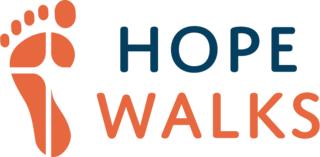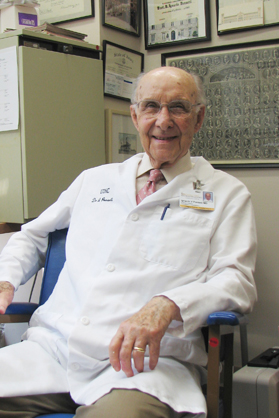
Scoliosis is a medical condition in which a person's spine has a sideways curve. The curve is usually "S"- or "C"-shaped over three dimensions. In some, the degree of curve is stable, while in others, it increases over time. Mild scoliosis does not typically cause problems, but more severe cases can affect breathing and movement. Pain is usually present in adults, and can worsen with age.

Orthopedic surgery or orthopedics, is the branch of surgery concerned with conditions involving the musculoskeletal system. Orthopedic surgeons use both surgical and nonsurgical means to treat musculoskeletal trauma, spine diseases, sports injuries, degenerative diseases, infections, tumors, and congenital disorders.

Clubfoot is a birth defect where one or both feet are rotated inward and downward. The affected foot and leg may be smaller than the other. Approximately 50% of cases of clubfoot affect both feet. Most of the time, it is not associated with other problems. Without treatment, the foot remains deformed, and people walk on the sides of their feet. This may lead to pain and difficulty in walking.

Arthrogryposis (AMC) describes congenital joint contracture in two or more areas of the body. It derives its name from Greek, literally meaning "curving of joints".

Shriners Children's is a network of non-profit medical facilities across North America. Children with orthopaedic conditions, burns, spinal cord injuries, and cleft lip and palate are eligible for care and receive all services in a family-centered environment, regardless of the patients' ability to pay. Care for children is usually provided until age 18, although in some cases, it may be extended to age 21.

University of Iowa Hospitals and Clinics (UIHC) is an 811-bed public teaching hospital and level 1 trauma center affiliated with the University of Iowa. UI Hospitals and Clinics is part of University of Iowa Health Care, a partnership that includes the University of Iowa Roy J. and Lucille A. Carver College of Medicine and the University of Iowa Physicians group practice.
Foot and ankle surgery is a sub-specialty of orthopedics and podiatry that deals with the treatment, diagnosis and prevention of disorders of the foot and ankle. Orthopaedic surgeons are medically qualified, having been through four years of college, followed by 4 years of medical school to obtain an M.D. or D.O. followed by specialist training as a resident in orthopaedics, and only then do they sub-specialise in foot and ankle surgery. Training for a podiatric foot and ankle surgeon consists of four years of college, four years of podiatric medical school (D.P.M.), 3–4 years of a surgical residency and an optional 1 year fellowship.
The Ponseti method is a manipulative technique that corrects congenital clubfoot without invasive surgery. It was developed by Ignacio V. Ponseti of the University of Iowa Hospitals and Clinics, USA in the 1950s, and was repopularized in 2000 by John Herzenberg in the USA and Europe and in Africa by NHS surgeon Steve Mannion. It is a standard treatment for clubfoot.

Hip dysplasia is an abnormality of the hip joint where the socket portion does not fully cover the ball portion, resulting in an increased risk for joint dislocation. Hip dysplasia may occur at birth or develop in early life. Regardless, it does not typically produce symptoms in babies less than a year old. Occasionally one leg may be shorter than the other. The left hip is more often affected than the right. Complications without treatment can include arthritis, limping, and low back pain.

University of Iowa Stead Family Children's Hospital formerly University of Iowa Children's Hospital and Children's Hospital of Iowa is a pediatric acute care academic children's hospital located in Iowa City, Iowa. The hospital was founded in 1919 and its current facility, opened in 2017, overlooks the university's football home, Kinnick Stadium. The hospital has 190 inpatient pediatric beds and is affiliated with the University of Iowa Carver College of Medicine. The hospital provides comprehensive pediatric specialties and subspecialties to pediatric patients aged 0–21 throughout Iowa and is one of the only children's hospitals in the region and state. University of Iowa Stead Family Children's Hospital also features the only ACS verified Level 1 Pediatric Trauma Center in the state.
CURE International is a Christian nonprofit organization based in Grand Rapids, Michigan. CURE's efforts are focused on providing medical care to children suffering primarily from orthopedic and neurological conditions. The organization's stated mission is "healing the sick and proclaiming the kingdom of God." The organization operates hospitals in Ethiopia, Kenya, Malawi, Niger, the Philippines, Uganda and Zambia. CURE also operates a pediatric specialty training program called CURE Neuro helping children with hydrocephalus and spina bifida survive and thrive through global partnerships. Since its inception, CURE Neuro has trained 41 surgeons from 23 low- and middle-income countries.
Unlike the flexible flat foot that is commonly encountered in young children, congenital vertical talus is characterized by presence of a very rigid foot deformity. The foot deformity in congenital vertical talus consists of various components, namely a prominent calcaneus caused by the ankle equines or plantar flexion, a convex and rounded sole of the foot caused by prominence of the head of the talus, and a dorsiflexion and abduction of the forefoot and midfoot on the hindfoot. It gets its name from the foot's resemblance to the bottom of a rocking chair. There are two subcategories of congenital vertical talus namely idiopathic or isolated type and non-idiopathic type which may be seen in association with arthrogryposis multiplex congenital, genetic syndromes and other neuromuscular disorders.
Dr. John F. Sarwark is Martha Washington Foundation Professor of Pediatric Orthopedics at Lurie Children's Hospital; Former Head, Pediatric Orthopedic Surgery, Lurie Children’s Hospital; and Professor of Orthopaedic Surgery, Northwestern University's Feinberg School of Medicine in Chicago, Illinois.

The University Orthopaedic Center is the only full-service specialty center of its kind in the Intermountain West, including services in joint reconstruction, sports medicine, pediatric orthopaedics, spinal disorders, hand, foot and ankle, trauma, musculoskeletal oncology, shoulder and elbow, and physical therapy.
Children's feet are smaller than those of adults, not reaching full size until the ages of 13 in girls and 15 in boys. There are correspondingly small sizes of shoes for them. In poor populations and tropical countries, children commonly go barefoot.
Orthopedic templating is a process wherein surgeons using either acetate templates or digital templates estimate the correct size of the prosthesis to be used in surgery. The biggest educator on the subject has been AO/ASIF. In a study published in the Injury journal published in 1998, 94% of consultants and 100% of trainees felt that planning was important but half, respectively, routinely planned fracture treatment.
Puliyur Krishnaswamy Duraiswami (1912–1974) was an Indian orthopedic surgeon, medical writer and the Director General of Health Services under the Government of India. Besides being a Fellow of the Royal College of Surgeons of England and a founder Fellow of the National Academy of Medical Sciences, he published several articles on orthopedics and was a recipient of Robert Jones Medal and the Presidential Merit Award of the British Orthopaedic Association. The Government of India awarded him the third highest civilian honour of the Padma Bhushan, in 1966, for his contributions to the Medical Science.

David B. Levine is an orthopaedic surgeon, hospital administrator, professor and historian of medicine who has held positions since 1961 at the Hospital for Special Surgery in New York City, New York.

Hope Walks, formerly CURE Clubfoot, is a Christian nonprofit organization based in Dillsburg, Pennsylvania, that treats infant clubfoot in developing countries around the world. As of 2019, Hope Walks operates over 130 clinics in 16 countries including Ethiopia, Niger and the Dominican Republic. Since 2006, over 135,000 children have been enrolled in the program for treatment.

Ruth Wynne-Davies or Ruth Blower (1926–2012) was a British medical doctor and scholar of orthopaedics. She researched and wrote about clubfoot and scoliosis.












